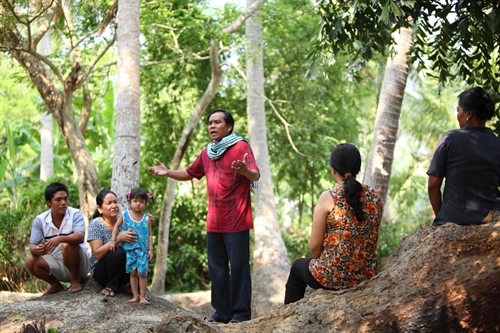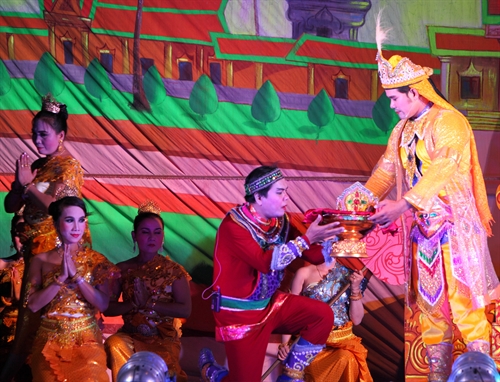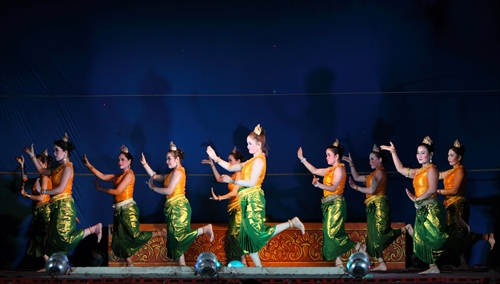 Sunday/Weekend
Sunday/Weekend

Rô Băm, a unique style of musical theatre created by the Khmer community in southern Việt Nam, has been alive for 200 years. Now, the art is being preserved by veteran and young artists of a troupe in Sóc Trăng Province, home of 400,000 Khmer.
 |
| Nature’s stage: Rô Băm artists visit many villages of Sóc Trăng and neighbouring provinces, including Bạc Liêu, Trà Vinh, Kiên Giang and Cà Mau, to offer outdoor shows. VNA/VNS Photos Nguyễn Luân |
SÓC TRĂNG — Rô Băm, a unique style of musical theatre created by the Khmer ethnic community in southern Việt Nam, has been alive for 200 years. Now, the art is being preserved by both veteran and young artists of a troupe in Sóc Trăng Province, home of 400,000 Khmer.
The Rô Băm Bưng Chông Art Troupe of Trần Đề District has travelled around the region to offer a series of ethnic performances.
Its performances provide local people and youth with the knowledge of Rô Băm and its songs and dances.
“Our artists also offer free training for young farmers, who love to sing and dance traditional tunes,” said 56-year-old performer Lâm Thị Hương, head of the troupe.
Using their strong voice and dance skills, Hương and her peers impress their audiences with popular plays, and delve into the daily life hopes and dreams of Khmer people in southern provinces.
They have visited many villages of Sóc Trăng and neighbouring provinces, including Bạc Liêu, Trà Vinh, Kiên Giang and Cà Mau, to feature the art.
Their outdoor shows, at low prices or for free, feature the culture of Khmer people.
In traditional Khmer clothes, they sing, dance and stage plays based on the religions, traditional customs and culture of the Khmer.
"Through our art, we hope to give people, particularly youngsters, the opportunity to learn about and enjoy the folk theatre. Our audiences can find out how rich their culture is as well as gain lessons about the nature, people, love and life, which are often featured in Rô Băm plays,” said Hương, who has more than 40 years working for the troupe.
Hương is the fifth generation of her family involved in Rô Băm. She began singing on the stage at the age of 13 after learning the art from her grandparents and parents.
“All of my family’s members have been involved in performing and teaching Rô Băm, which was created by the ethnic Khmer people a long time ago and spread widely with Dù Kê, another genre of Khmer theatre, in the region in 1920s,” Hương said.
The Rô Băm Bưng Chông troupe has 23 performers, including singers and musicians, most of them from farmer families.
“My children, Mỹ Hạnh, Thạch Nauy and Nacy Lươl, are young talents in Rô Băm, who have more than 10 years of performing,” said Hương, who began her management job in 2010 after the death of her older brother, Lâm Phương, the former head of the troupe.
“We often work on new shows to entertain villagers and children during the Tết (Lunar New Year) and the Khmer new year festival Chôl Chơ Năm Thmây (which begins in the third month of the lunar calendar).”
“I face many new challenges but my love for Rô Băm keeps me going forward,” she said.
Last year, Hương was invited to teach Rô Băm to young actors of the Kiên Giang Khmer Art Troupe.
“I have worked hard to infuse my love and skills for the art to younger generations in the hope of giving Khmer theatre a long life,” Hương said.
Đào Chuông, former head of the Kiên Giang Khmer Art Troupe, said: “Hương is one of the region’s very few professional performers, who has kept Rô Băm original and unique on stage. Thanks to her troupe, the traditional theatre of Khmer people would be expanded.” —VNS
 |
| Artistic heritage: Rô Băm, a unique style of musical theatre created by the Khmer community in southern Việt Nam, is being preserved by farmer artisans living in Sóc Trăng Province, home to 400,000 Khmers. |
 |
| Keep it going: Rô Băm, a genre of Khmer theatre, is alive thanks to performers of the Rô Băm Bưng Chông Art Troupe of Sóc Trăng Province’s Trần Đề District. |




